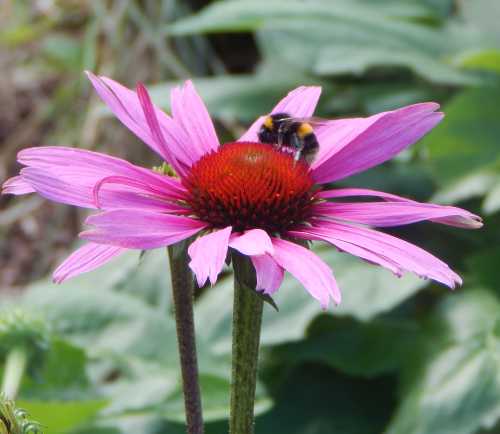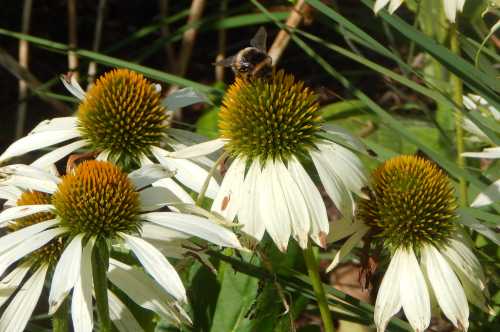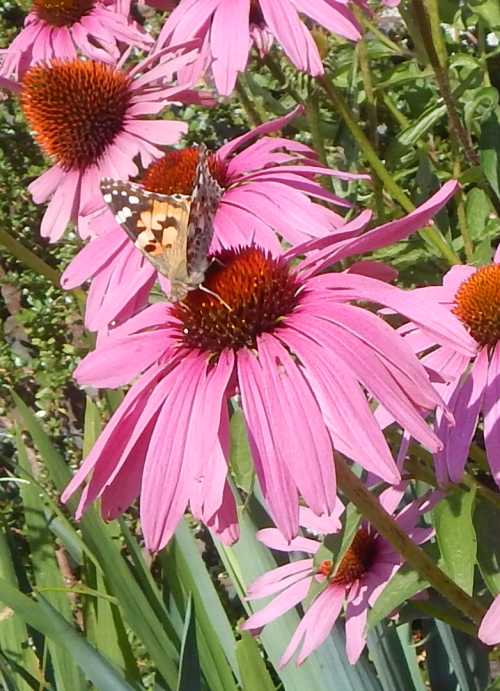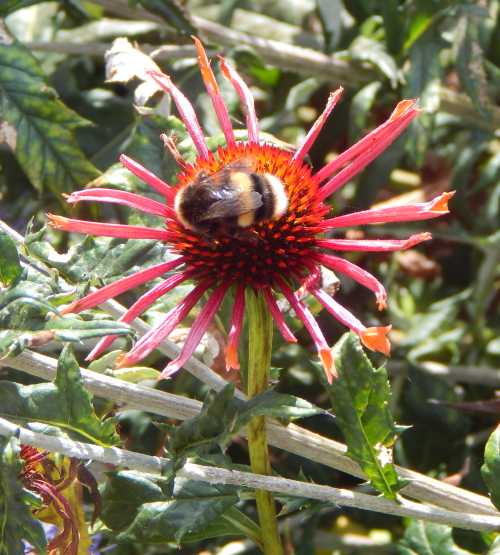Plant Echinacea (Coneflower) For Bees
These wonderful, large daisy-like flowers are among my absolute favourites. They are one of the 'Coneflowers' along with Helenium (sneezeweed) and Rudbeckia. Bees and butterflies feed on the large centres, which become more cone-shaped and prominent with age.
They need full sun and like well-drained soil, but other than that, they are fairly easy to grow.
Look out for wonderful shades of pink, orange, copper, white and buttercup yellows.
Echinacea flowers are popular with bees and butterflies
Although some varieties will flower from early summer, the later flowering varieties are a real help to bees and butterflies to feed emerging young, and help new queen bumble bees that need to build their energy reserves ready for mating, and then seek out a suitable location to hibernate.
 These wonderful, large daisy-like flowers are among my absolute favourites - bees love them too.
These wonderful, large daisy-like flowers are among my absolute favourites - bees love them too. Look out for wonderful shades of pink, orange, copper, white and buttercup yellows.
Look out for wonderful shades of pink, orange, copper, white and buttercup yellows.
Echinacea coneflowers are described as tough perennials, but they dislike being moved, so decide where their permanent spot will be before planting. If you want to divide the plants, wait until clumps have become dense, and take action only at the end of the flowering season.
 Butterflies visit Echinacea flowers too.
Butterflies visit Echinacea flowers too.
There are a number of different types of Echinacea, including some with petals that curl inward as they develop, and those with petals that droop downward.
Echinacea coneflower have tall, sturdy stems, so they can be positioned to the rear of the border, although I like to see them in large swathes close to the front.
However, if you need a medium sized specimen to fill a space in the flower border, compact varieties are available.
 Bumble bee foraging on an Echinacea flower with inward curling petals.
Bumble bee foraging on an Echinacea flower with inward curling petals.
Which varieties of Echinacea should I choose to help me attract bees and butterflies to my garden?
As far as I can make out, they are pretty much all attractive to bees and butterflies, so you can pay more attention to details such as size, flowering time and duration, and whether or not you want whites, greens, pinks, orange, yellows or red.
Here are some of my favourites:
Shades of white/cream
- Echinacea purpurea 'Virgin'
- Echinacea purpurea 'White Swan'
- Echinacea purpurea 'Fragrant Angel'
Shades of pink
- Echinacea purpurea purple coneflower
- Echinacea purpurea 'Ruby Giant'
- Echinacea purpurea 'The King'
- Echinacea purpurea 'Rubinglow'
- Echinacea purpurea 'Magnus'
- Echinacea purpurea 'Pica Bella'
- Echinacea purpurea 'Magnus Superior'
Shades of yellow/orange
- Echinacea 'Flame Thrower'
- Echinacea 'Summer Cocktail' (gorgeous orange-yellow with a pink blush)
- Echinacea 'Tiki Torch' (PBR) (gorgeous orange)
- Echinacea 'Parrot' (half red, half yellow petals: lovely red centre with petals turning orangey yellow)
- Echinacea 'Daydream' (gorgeous vibrant yellow)
Shades of green
- Echinacea purpurea 'Green Twister' (beautiful petals – pink around the flower centre, and pale green toward the edges of the petals)
- Echinacea purpurea 'Green Jewel'
Shades of Red
- Echinacea 'Sundown'
Whichever variety of Echinacea you select, they'll look beautiful in a border nest to striking sapphire blues. I also especially like the paler green, white and yellow varieties with purples and vibrant orange.
However you choose to display them, I'm sure the bees and butterflies will love to visit.
More articles about bees and plants
- Bees And Brambles: The Value Of Brambles To Bees Also known as blackberry bush, research shows each bramble flower secretes lots of nectar for bees!
- Bees And Bee Balm Bee Balm (Monarda) - also known as 'Bergamot) is a herbaceous perennial which is attractive for bees.
- 30 Fantastic Garden Flowers For Bees Flowering plant recommendations for the perfect bee garden.
- Bees love lupins – but so do slugs and snails, so what can you do? Here's a way to protect your lupins....using garlic!
- Plant Oregano For Bees (Marjoram) It's rich in nectar, and attracts bees, butterflies and hoverflies in summer. Here's how to plant it.
- Fennel Pollen And Nectar Bees love fennel! How to grow it, gather it, and the many uses of fennel seeds and pollen.
If you found this page helpful or interesting, I'd really be grateful if you would share it with others - if not this page, perhaps another, such as Gardening For Bees.
Thank you so much :) .